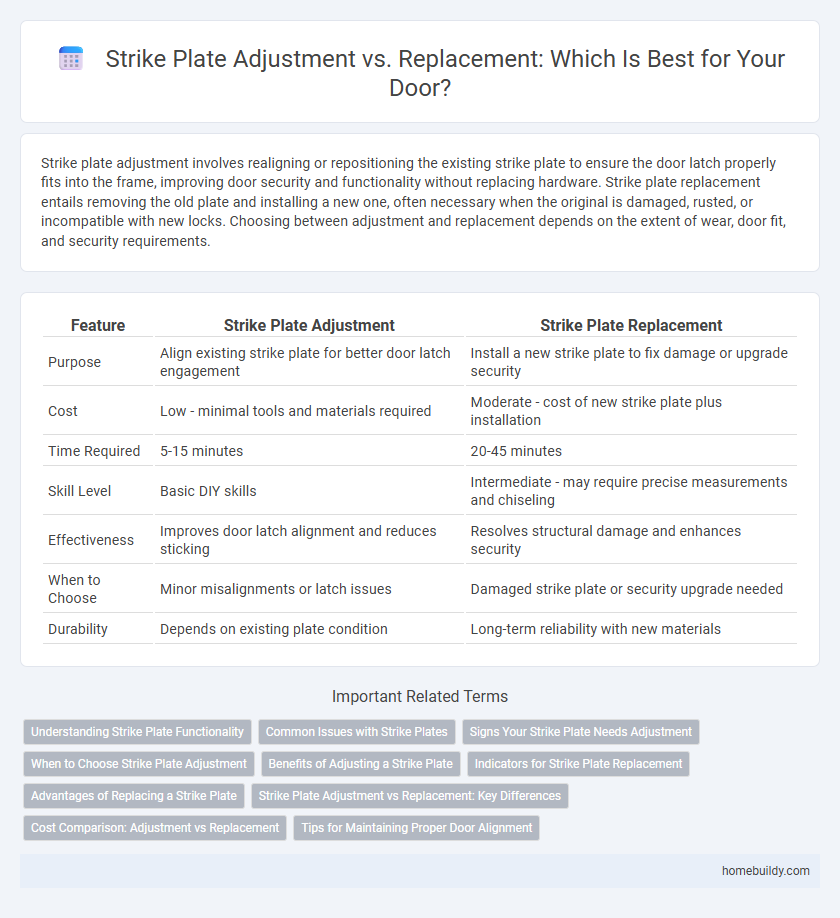Strike plate adjustment involves realigning or repositioning the existing strike plate to ensure the door latch properly fits into the frame, improving door security and functionality without replacing hardware. Strike plate replacement entails removing the old plate and installing a new one, often necessary when the original is damaged, rusted, or incompatible with new locks. Choosing between adjustment and replacement depends on the extent of wear, door fit, and security requirements.
Table of Comparison
| Feature | Strike Plate Adjustment | Strike Plate Replacement |
|---|---|---|
| Purpose | Align existing strike plate for better door latch engagement | Install a new strike plate to fix damage or upgrade security |
| Cost | Low - minimal tools and materials required | Moderate - cost of new strike plate plus installation |
| Time Required | 5-15 minutes | 20-45 minutes |
| Skill Level | Basic DIY skills | Intermediate - may require precise measurements and chiseling |
| Effectiveness | Improves door latch alignment and reduces sticking | Resolves structural damage and enhances security |
| When to Choose | Minor misalignments or latch issues | Damaged strike plate or security upgrade needed |
| Durability | Depends on existing plate condition | Long-term reliability with new materials |
Understanding Strike Plate Functionality
Strike plate adjustment involves repositioning the existing strike plate to ensure proper alignment with the door latch, enhancing security and smooth operation without the need for new hardware. Strike plate replacement becomes necessary when the plate is damaged, warped, or corroded, compromising the door's locking mechanism and structural integrity. Understanding strike plate functionality highlights its role in securing door latches, distributing impact forces, and preventing wear on door frames, making precise installation crucial for optimal performance.
Common Issues with Strike Plates
Misaligned strike plates often cause door latching problems, requiring precise adjustment to realign the latch with the plate for smooth operation. Worn or damaged strike plates usually demand replacement to restore secure door closure and prevent lock failure. Frequent issues include stripped screw holes and bent plates, which compromise lock functionality and security.
Signs Your Strike Plate Needs Adjustment
Signs your strike plate needs adjustment include difficulty latching the door securely, noticeable gaps between the door and frame, and misalignment causing the lock bolt to miss the strike plate hole. Warping or wear on the strike plate that causes uneven contact points can also indicate adjustment is necessary over replacement. Timely adjustments improve lock efficiency and prevent unnecessary strike plate replacements, extending door hardware lifespan.
When to Choose Strike Plate Adjustment
Strike plate adjustment is ideal when minor misalignment causes the door latch to not engage properly, often due to settling or slight warping. It enhances door security and functionality without the cost and effort of full strike plate replacement. Choose adjustment for quick fixes that restore proper latch alignment and improve door locking performance.
Benefits of Adjusting a Strike Plate
Adjusting a strike plate enhances door alignment without the cost and effort of full replacement, improving security and functionality swiftly. Precise adjustment reduces wear on the door latch and frame, extending the lifespan of both components. This solution offers a cost-effective way to address issues like misalignment and sticking doors while maintaining the original hardware's integrity.
Indicators for Strike Plate Replacement
Strike plate replacement becomes necessary when signs such as visible metal deformation, cracked or broken plates, and persistent misalignment that causes latch or bolt failure are evident. Indicators also include recurring door misalignment despite multiple adjustments and deterioration from rust or wear compromising security. When strike plate adjustments fail to restore proper function or security, replacement is the most effective solution to ensure door integrity and lock performance.
Advantages of Replacing a Strike Plate
Replacing a strike plate enhances door security by providing a fresh, sturdier metal surface that better resists forced entry compared to worn or misaligned plates. It ensures precise alignment with the latch or bolt, reducing door rattling and improving lock efficiency for consistent performance. New strike plates often come with reinforced designs and longer screws that increase the overall durability and strength of the door frame.
Strike Plate Adjustment vs Replacement: Key Differences
Strike plate adjustment involves repositioning the existing plate to align properly with the door latch, enhancing security and ease of use without the cost of new hardware. Replacement requires installing a new strike plate, often necessary if the current one is damaged, worn, or incompatible with upgraded locks. Adjustments prioritize minor realignments using tools, while replacements address significant damage or upgrade needs, impacting installation time and cost.
Cost Comparison: Adjustment vs Replacement
Adjusting a lock strike plate typically involves minor labor and costs under $50, making it a cost-effective solution for alignment issues. Strike plate replacement ranges from $75 to $200, factoring in new hardware and professional installation fees. Choosing adjustment over replacement saves money when the original plate remains structurally sound and properly fits the door frame.
Tips for Maintaining Proper Door Alignment
Maintaining proper door alignment hinges on precise strike plate adjustment, which ensures the latch engages smoothly without forcing the door. Regularly inspect the strike plate for wear and misalignment, and use a screwdriver to reposition it for optimal fit, preventing gaps and sticking. Strike plate replacement becomes necessary only when adjustments fail to correct damage or warping, preserving both security and door functionality.
strike plate adjustment vs strike plate replacement Infographic

 homebuildy.com
homebuildy.com